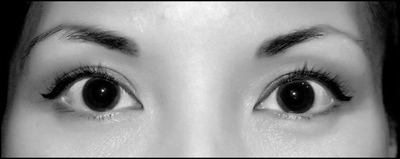55. The Eyes Have It
Relax!

• “I like that person; he/she looks you straight in the eye!”
• “I don’t like that person; he/she is shifty-eyed!”
These two familiar exclamations define the polar opposites of eye contact, the most essential element in interpersonal communication. But effective eye contact has another little-known but important benefit: calming the user.
Whenever you—or any presenter—stand up in front of any audience, the stress of the moment triggers an adrenaline rush that sets your whole body into the accelerated motion of Fight or Flight, particularly your eyes, which sweep the room in search of escape routes.
The rapid eye movement makes you appear furtive to your audience, which makes feel them uneasy; when you sense their uneasiness, you become more stressed, which heightens your adrenaline rush, which makes your eyes move faster and...a vicious cycle.
It gets worse.
During the sweep, your eyes take in a great deal of sensory data. All of that data must be processed by your brain, which increases your stress, which heightens your adrenaline rush, which makes your eyes sweep faster; the faster your eyes move, the more data you take in... the vicious cycle compounds.
Instead, look at each individual in your audience long enough to see that person look back at you. This simple step diminishes your rapid eye movement. Readers of The Power Presenter will recognize this technique as “Eye Connect,” a more pronounced form of eye contact. With Eye Connect, you engage fully with each member of your audience. Contrast this approach with the scanning that most presenters do in their attempt to make eye contact. Connect with every person you see by waiting until you see that person look back at you, by waiting until you make the connection.
While Eye Connect decreases the frequency of your eye movement, it also decreases the amount of sensory data your brain has to process, which reduces your stress, lowers your adrenaline rush, and makes you calmer.
The calming effect created by diminished eye movement has an analogy in scuba diving. Karyn Scott, the Director of Enterprise Segment Marketing at Cisco, is a certified scuba diver. She explains that when she sees a novice diver panic under water, she swims to that person and gives hand signals—pointing two fingers rapidly back and forth between that person’s eyes and hers—directing the person to look her in the eye. As soon as the person’s eyes stop darting, his or her panic subsides, and the air bubbles coming from the diver’s regulator quickly slow down. Connecting eye to eye with another human is so powerful there’s almost no need for words.
Bruce Iliff, an Australian scuba Divemaster, has a variation of Ms. Scott’s method: He recommends that when divers start to panic, they should “look at the surface. At 20 metres the surface looks so close you could reach out and touch it, a comforting thought!”1
In essence, both Mr. Iliff and Ms. Scott are advocating the same method you can use when you present: Look at each person in your audience until you see that person look back. That simple but powerful step will decrease the frequency of your eye movement, increase the duration of your engagement—and make you calmer.
That’s Eye Connect.
